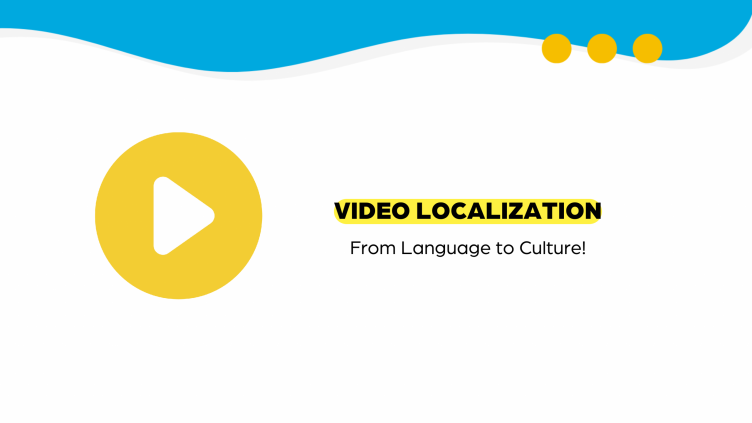Table of contents
- What is Video Localization?
- The Power of Subtitling
- Engagement through Video Localization
- Unleashing Human Value: Fostering Cultural Understanding
- Cultural Accessibility: Making Other Cultures Reachable
- The Broader Implications: Video Localization in a Global Context
- The Future of Video Localization
Video Localization: From Language to Culture

This blog post titled “Video Localization: From Language to Culture” explores the significance of video localization and the power of subtitles in bridging language and cultural barriers in the global film industry and business world. Find out how video localization enhances the viewer experience, empowers businesses to expand their reach, and fosters cross-cultural understanding.
Finally, the blog also highlights real-world examples of successful video localization strategies used by companies like Coca-Cola and Nike. We will showcase the benefits of adapting videos to resonate with diverse audiences. Overall, the blog aims to showcase the transformative impact of video localization and subtitles in creating a more inclusive and culturally accessible world.
What is Video Localization?
Video localization has revolutionized the way we consume and engage with video content in our increasingly interconnected world. It involves the adaptation of videos to different linguistic and cultural contexts, ensuring that they resonate with diverse audiences around the globe. We will delve deeper into the significance of video localization, its impact on movies, businesses, and the broader implications it has on cultural accessibility.
Let’s explore how video localization enhances the viewer experience, empowers businesses to expand their reach, and fosters cross-cultural understanding, ultimately bridging the cultural gap in our diverse world.
Elevating Visual Content to New Heights

The translations for the subtitles are done in a way that a foreign viewer would understand it in his cultural context.
In the ever-expanding global film industry, subtitles have emerged as a powerful tool, breaking down language barriers and captivating audiences worldwide. While some may perceive subtitles as a mere translation of the dialogue, their impact goes far beyond that. Subtitles play a crucial role in the success of movies, enabling viewers to immerse themselves in the cinematic experience, regardless of their native language. Films like “Crouching Tiger, Hidden Dragon” and “Parasite” stand as shining examples of how subtitles have contributed to their international acclaim.
The Power of Subtitling
When it comes to foreign-language films, accurate translation through subtitles is essential for effectively conveying the story and preserving the authenticity of the original dialogue. Subtitling is not a task to be taken lightly; it requires meticulous attention to detail to capture the nuances, cultural references, and wordplay embedded in the script. A skilled subtitler must understand the context, language, and cultural elements of both the source and target languages, ensuring that the subtitles faithfully represent the filmmaker’s vision.
Beyond the realm of translation, subtitles serve as a linguistic bridge, enabling viewers to fully appreciate the subtitles, emotions, and cultural context embedded in the storytelling. They allow audiences to connect with characters, understand their motivations, and empathize with their experiences.

A Chinese movie, Crouching Tiger, Hidden Dragon, was widely loved across the globe, thanks to subtitling.
For instance, in “Crouching Tiger, Hidden Dragon,” the elegant dialogue between the characters is not lost in translation. The English subtitles manage to convey the poetic nature of the Mandarin lines, amplifying the impact of the film’s lyrical beauty.
Educational Value
Moreover, subtitles enhance the educational value of films, making them valuable tools for language learning. As viewers engage with subtitled movies, they are exposed to different languages, idiomatic expressions, and colloquialisms. This exposure not only enriches their linguistic knowledge but also fosters cross-cultural understanding. Subtitles, in this sense, serve as a gateway to diverse cultures and facilitate the exploration of new perspectives.

Parasite, a South-Korean movie, swept all the big accolades at the Oscars, all thanks to its localization efforts.
To illustrate the impact of subtitles further, consider the groundbreaking success of “Parasite.” Director Bong Joon-ho’s masterful storytelling, combined with the film’s skillful subtitling, transcended language barriers and captivated audiences worldwide. The subtitles in “Parasite” effectively conveyed the social nuances and class commentary, allowing viewers from various backgrounds to grasp the film’s underlying messages fully.
Empowering Businesses
Localization also helps business scale very quickly.
Engagement through Video Localization
In today’s globalized marketplace, video localization has become a vital asset for businesses looking to expand their reach and connect with diverse markets. Beyond the world of movies, video content localization offers a powerful tool for effectively communicating a brand’s message to a global audience. By localizing videos, companies can go beyond language translation and adapt cultural references, idioms, and humor to resonate with their target markets. This approach fosters a deeper connection with viewers, leading to increased engagement, customer loyalty, and, ultimately, business growth.
ROI through Video Localization
When businesses localize their videos, they demonstrate a genuine understanding of their target audience’s preferences and sensibilities. By speaking the language—both literally and metaphorically—companies can break down cultural barriers and establish meaningful connections with customers worldwide. This localization-driven engagement often translates into higher conversion rates, increased brand recognition, and improved return on investment (ROI).
To delve deeper into the benefits of video localization, let’s consider some engaging examples:

Coca-Cola used local names on its bottles to attract customers from that specific country.
Coca-Cola’s “Share a Coke” Campaign
Coca-Cola successfully localized its video advertisements by customizing the names on its bottles and cans to reflect the diversity of different markets. For instance, in China, the campaign featured Chinese characters on the packaging, resonating with local consumers. By personalizing their product and incorporating local culture, Coca-Cola engaged customers on a more personal level, resulting in increased brand loyalty and sales.
Nike’s Global Marketing Campaigns
Nike is renowned for its successful video localization strategies. The company adapts its commercials to various markets, featuring local athletes, cultural references, and languages. For example, during the FIFA World Cup, Nike created localized videos for different countries, showcasing local football stars and incorporating regional fan cultures. By tailoring its videos to resonate with specific markets, Nike effectively engages viewers and strengthens its global brand presence.
Unleashing Human Value: Fostering Cultural Understanding
Video localization serves as a powerful catalyst for fostering cross-cultural understanding, unlocking immense human value. By making video content accessible in multiple languages, localization becomes a conduit for cultural exchange and appreciation, bridging the gap between diverse communities.
When language barriers are broken down through video localization, it paves the way for empathy, dismantles stereotypes, and nurtures a global community that embraces and celebrates diversity. Let’s explore in more detail how video localization promotes cultural understanding:
Travel and Tourism
The travel industry heavily relies on video localization to showcase destinations and experiences to an international audience. Travel videos that incorporate multilingual subtitles or voice-overs allow viewers from different countries to explore and understand the cultural richness of a place. For instance, a travel video about Japan could feature localized subtitles that explain the significance of traditional tea ceremonies, sumo wrestling, or cherry blossom festivals. This not only promotes tourism but also encourages viewers to appreciate and respect the unique customs and traditions of the country.
Documentaries
Documentary filmmakers often employ video localization to bring their narratives to a global audience. By translating interviews, narration, and on-screen text, documentaries become accessible to people worldwide, enabling them to gain profound insights into different cultures and societies. For example, the documentary “Jiro Dreams of Sushi” explores the artistry and dedication behind a renowned sushi chef in Japan. Through video localization, viewers from diverse backgrounds can appreciate the meticulous craftsmanship, cultural values, and culinary traditions depicted in the film.
Cultural Accessibility: Making Other Cultures Reachable
Video localization acts as a powerful tool to increase the accessibility of diverse cultures, fostering curiosity, respect, and admiration for their unique attributes. By localizing videos, individuals are provided with an opportunity to gain profound insights into the customs, traditions, and perspectives of societies they might not have otherwise encountered.
Let’s delve into more detail on how video localization promotes cultural accessibility:
Food and Cuisine
Food is a universal language that transcends cultural boundaries. By localizing videos that showcase traditional recipes and cooking techniques, viewers can explore the culinary traditions of different cultures. For example, a localized video featuring Mexican cuisine can introduce viewers to the vibrant flavors of tacos, tamales, and mole. The video may also provide cultural context, explaining the significance of certain ingredients or cooking methods. This not only allows viewers to appreciate the diversity of global cuisine but also encourages them to try new flavors and embrace culinary traditions from around the world.
Festivals and Celebrations
Localized videos can provide a window into the vibrant festivities and cultural celebrations of different communities. For instance, a video showcasing the Chinese New Year celebrations could include localized subtitles or voice-overs explaining the significance of lion dances, red envelopes, and traditional greetings. By experiencing these cultural celebrations through video, viewers gain a deeper understanding of the customs, symbolism, and shared joy associated with such events.
The Broader Implications: Video Localization in a Global Context
Video localization is not just a commercial strategy or a tool for cultural exchange; it holds profound implications for our globalized world. It shapes the way we communicate, consume media, and perceive the world around us. As technology continues to connect us across geographical boundaries, video localization plays a vital role in fostering meaningful interactions between people from diverse cultures.
To delve deeper into the engaging and detailed aspects of video localization in a global context, let’s explore some examples:
Cross-Cultural Collaborations
Video localization opens doors for cross-cultural collaborations, enabling artists, filmmakers, and content creators from different regions to work together. For instance, a music video collaboration between an American artist and a Korean artist may incorporate subtitles or translations to ensure that the lyrics and message are understood by viewers worldwide. Such collaborations not only blend creative talents but also encourage cultural exchange, leading to the creation of unique and diverse content.
International Knowledge-Sharing
Video localization plays a crucial role in disseminating knowledge and educational content across borders. Online platforms, such as TED Talks, often provide localized subtitles in multiple languages, making insightful talks accessible to a global audience. This fosters the exchange of ideas, expertise, and perspectives, transcending language barriers and facilitating intellectual growth worldwide.
The Future of Video Localization
Video localization has already demonstrated its immense impact in bridging cultural gaps and facilitating global communication. However, its potential for the future is even more promising. As technology advances and our world becomes increasingly interconnected, video localization will continue to play a crucial role in shaping how we perceive and interact with different cultures. Let’s explore the future possibilities of video localization:
Advancements in Machine Learning and Artificial Intelligence
The development of machine learning and artificial intelligence (AI) technologies will revolutionize the process of video localization. AI-powered algorithms can analyze and translate video content more accurately, making the localization process faster and more efficient. These advancements will enable businesses, filmmakers, and content creators to reach wider audiences and expand their global reach with greater ease.
Personalized Video Localization
In the future, video localization will likely become more personalized, catering to individual viewer preferences. AI algorithms can analyze user data and provide customized subtitle options, allowing viewers to choose their preferred language, font size, style, and even content adaptations based on their cultural background or specific needs. This personalized localization approach will enhance viewer engagement and create more inclusive viewing experiences.
Real-Time Video Localization
With the advancements in real-time translation technologies, video localization in the future may extend beyond post-production processes. Live-streamed events, conferences, and interviews can be simultaneously translated into multiple languages, enabling real-time accessibility and engagement for global audiences. This will foster immediate cross-cultural communication and collaboration on a global scale.

With this, we would like to end by extending our expertise and services to you if you are looking to localize your video content. Trust Linguidoor to ensure that your content yields the best results in a foreign market. Contact us today!
Image Source: Pinterest

Made up your mind yet?
Empower your globalization goals today!




